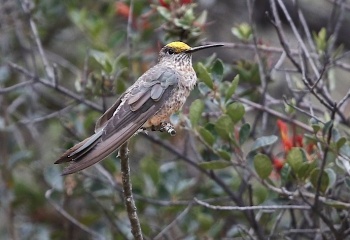Nomdeploom (talk | contribs) |
Aloktewari (talk | contribs) (copyright symbol to images) |
||
| (10 intermediate revisions by 5 users not shown) | |||
| Line 1: | Line 1: | ||
| − | + | [[Image:Giant_Hummingbird_by_ejaramillo.jpg|thumb|550px|right|Male of subspecies ''peruviana''<br />Photo © by {{user|ejaramillo|ejaramillo}} <br />Cuenca, [[Ecuador]], May 2005]] | |
| − | [[Image: | ||
| − | |||
;[[: Category:Patagona|Patagona]] gigas | ;[[: Category:Patagona|Patagona]] gigas | ||
==Identification== | ==Identification== | ||
| + | [[Image:Giant Hummingbird female .jpg|thumb|350px|right|Female, subspecies ''peruviana'' (golden crown is pollen)<br />Photo © by {{user|Stanley+Jones|Stanley Jones}}<br />Cordillera Blancas Huascarán National Park, Yungay, Ancash, [[Peru]], August 2017]] | ||
| + | 20-22 cm (7.9-8.7 ins)<br /> | ||
| + | In addition to its large size, this species is characteristic with green upperside and white rump patch. | ||
| + | ====Variations==== | ||
| + | The two subspecies differ in plumage with the northern ''peruviana'' showing cinnamon underside on the male, whitish underside with dark and cinnamon streaks in female; male southern ''giga'' has warm brown and females have greyish undersides. | ||
==Distribution== | ==Distribution== | ||
| − | Western [[South America]]. | + | Western [[South America]]: found in [[Colombia]], [[Ecuador]], [[Peru]], [[Bolivia]], [[Chile]] and [[Argentina]]. |
| + | |||
==Taxonomy== | ==Taxonomy== | ||
| − | Two subspecies are recognized | + | ====Subspecies==== |
| + | [[Image:Giant_Hummingbird_juv_by_Rodrigo_Reyes.jpg|thumb|350px|Juvenile of subspecies ''gigas''<br />Photo © by {{user|Rodrigo_Reyes|Rodrigo Reyes}} <br />Cajón del Maipo, central [[Chile]], January 2008]] | ||
| + | Two subspecies are recognized<sup>[[#References|[1]]]</sup>: | ||
| + | *''P. g. peruviana'': | ||
| + | :*Andes of south-western [[Colombia]] to northern [[Chile]] and north-western [[Argentina]] | ||
| + | *''P. g. gigas'': | ||
| + | :*Central and southern [[Chile]] to west-central [[Argentina]] | ||
| + | |||
| + | This species has been mentioned as a potential split. | ||
==Habitat== | ==Habitat== | ||
| + | Likes open areas, mostly on dry ground. Likes Agave and other flowers with tall florescent stands. | ||
| + | |||
==Behaviour== | ==Behaviour== | ||
| + | ====Diet==== | ||
| + | Their diet includes Agave and Puya flowers. | ||
| + | ====Movements==== | ||
| + | Northern populations (subspecies ''peruviana'') are residents while ''gigas'' is a migratory subspecies. | ||
| + | ==References== | ||
| + | #{{Ref-Clements6thAug17}}#Alvaro Jaramillo. 2003. Birds of Chile. Princeton Field Guides. ISBN 0-691-11740-3 | ||
| + | #Restall et al. 2006. Birds of Northern South America. Yale University Press. ISBN 9780300124156 | ||
| + | #Handbook of the Birds of the World Alive (retrieved April 2014) | ||
| + | {{ref}} | ||
==External Links== | ==External Links== | ||
| − | |||
{{GSearch|Patagona+gigas}} | {{GSearch|Patagona+gigas}} | ||
[[Category:Birds]][[Category:Patagona]] | [[Category:Birds]][[Category:Patagona]] | ||
Latest revision as of 17:16, 15 January 2019
- Patagona gigas
Identification

Photo © by Stanley Jones
Cordillera Blancas Huascarán National Park, Yungay, Ancash, Peru, August 2017
20-22 cm (7.9-8.7 ins)
In addition to its large size, this species is characteristic with green upperside and white rump patch.
Variations
The two subspecies differ in plumage with the northern peruviana showing cinnamon underside on the male, whitish underside with dark and cinnamon streaks in female; male southern giga has warm brown and females have greyish undersides.
Distribution
Western South America: found in Colombia, Ecuador, Peru, Bolivia, Chile and Argentina.
Taxonomy
Subspecies
Two subspecies are recognized[1]:
- P. g. peruviana:
- P. g. gigas:
This species has been mentioned as a potential split.
Habitat
Likes open areas, mostly on dry ground. Likes Agave and other flowers with tall florescent stands.
Behaviour
Diet
Their diet includes Agave and Puya flowers.
Movements
Northern populations (subspecies peruviana) are residents while gigas is a migratory subspecies.
References
- Clements, J. F., T. S. Schulenberg, M. J. Iliff, D. Roberson, T. A. Fredericks, B. L. Sullivan, and C. L. Wood. 2017. The eBird/Clements checklist of birds of the world: v2017, with updates to August 2017. Downloaded from http://www.birds.cornell.edu/clementschecklist/download/
- Alvaro Jaramillo. 2003. Birds of Chile. Princeton Field Guides. ISBN 0-691-11740-3
- Restall et al. 2006. Birds of Northern South America. Yale University Press. ISBN 9780300124156
- Handbook of the Birds of the World Alive (retrieved April 2014)
Recommended Citation
- BirdForum Opus contributors. (2025) Giant Hummingbird. In: BirdForum, the forum for wild birds and birding. Retrieved 12 May 2025 from https://www.birdforum.net/opus/Giant_Hummingbird





